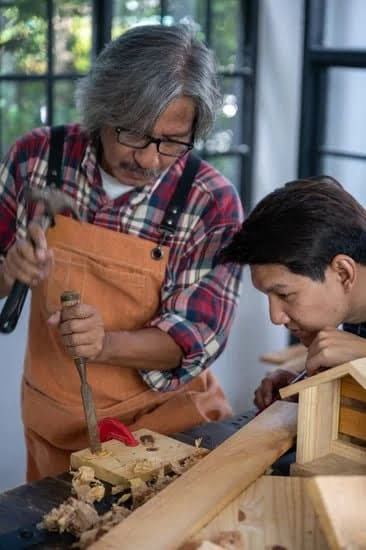Table clamps woodworking play a crucial role in ensuring the success of any woodworking project. Whether you’re a beginner or an experienced woodworker, these versatile tools are essential for securing materials in place, providing stability, and preventing movement during various tasks. In this article, we will delve into the world of table clamps and explore their importance, purpose, benefits, and the different types commonly used in woodworking.
Using table clamps offers numerous advantages when working with wood. One of the key benefits is their ability to hold materials securely in place, allowing for precise cuts, joinery work, or intricate designs without worrying about pieces shifting or moving unexpectedly. By immobilizing the workpiece, table clamps provide stability that is vital for achieving accurate results and maintaining safety throughout the process.
There are various types of table clamps available on the market, each with its own unique features and functionalities. Some commonly used types include C-clamps, F-clamps, bar clamps, and toggle clamps.
These clamps differ in their design and mechanism but share the common goal of providing reliable support during woodworking tasks. Depending on your specific needs and preferences for a particular project, understanding these different clamp options can help you choose the right tool for the job at hand.
In this comprehensive guide to table clamps woodworking, we will take a closer look at each type of clamp’s characteristics and explore how they excel in specific woodworking tasks. Additionally, we will discuss factors to consider when selecting a table clamp that suits your project requirements best. So whether you’re looking to fine-tune your knowledge or maximize your woodworking skills with these versatile tools, read on as we empower your projects with reliable table clamping techniques.
Understanding the Different Types of Table Clamps
When it comes to woodworking projects, table clamps are a must-have tool. These versatile clamps hold materials securely in place, ensuring precision and accuracy while you work. Understanding the different types of table clamps available can help you choose the right one for your specific woodworking task.
There are several types of table clamps commonly used in woodworking, each with its own unique features and functionalities. C-clamps, also known as G-clamps, are one of the most traditional types. They have a simple design consisting of a screw mechanism and two arms that create pressure when tightened. C-clamps are versatile and can be used for a wide range of woodworking tasks.
F-clamps, also called bar clamps or sliding-arm clamps, are another popular option. These clamps have a long sliding bar that can be adjusted to accommodate various sizes of workpieces. F-clamps provide strong and even pressure across the entire length of the clamp, making them ideal for larger projects.
Bar Clap
toggleclaps
Toggle clamps, on the other hand, are often used for specific applications where quick action and holding power are required. These clamps feature a handle that can be operated with one hand to lock or release the clamp’s jaw. Toggle clamps come in various styles such as horizontal toggle clamp and vertical toggle clamp.
Each type of table clamp has its advantages and is suitable for different woodworking tasks. For example:
- C-clamps are great for securing smaller pieces or joints.
- F-clamps excel at holding larger workpieces together during gluing or assembly.
- Toggle clamps provide quick and reliable holding power for jigs or fixtures.
By understanding the different types of table clamps available, you can select the right one to enhance your woodworking projects’ efficiency and precision.
| Type | Features | Applications |
|---|---|---|
| C-clamps | Simple screw mechanism, two arms for pressure | Securing smaller pieces or joints |
| F-clamps/Bar clamps | Long sliding bar, even pressure | Holding larger workpieces during gluing or assembly |
| Toggle clamps | Quick action, one-hand operation | Jigs or fixtures requiring quick and reliable holding power |
Choosing the right type of table clamp for your woodworking project depends on factors such as the material you’re working with, the size of your workpiece, and the level of pressure required. It’s essential to consider these factors when selecting a clamp to ensure a secure and stable hold. With the right table clamp, you can confidently tackle any woodworking task and achieve professional-level results.
Choosing the Right Table Clamp for Your Woodworking Project
When it comes to woodworking projects, having the right table clamp can make a significant difference in both efficiency and quality of your work. The right clamp ensures that your materials are securely held in place, allowing you to focus on precise cuts and measurements without worrying about movement or slippage. In this section, we will discuss the factors to consider when selecting a table clamp and how to match the clamp type with your specific woodworking task.
Factors to Consider When Selecting a Table Clamp:
Material
One important factor to consider is the material of the clamp itself. Clamps made from high-quality materials like steel or cast iron tend to be more durable and long-lasting, making them a wise investment for woodworking projects.
Size and Jaw Width
The size of the table clamp you choose should correspond to the size of your workpiece. Larger clamps with wider jaws provide more gripping capacity, while smaller clamps are suitable for delicate or narrow pieces.
Assessing Clamping Capacity and Stability:
Clamping Capacity
It’s crucial to assess the clamping capacity of different table clamps before making a selection. The clamping capacity refers to the maximum amount of force that can be applied by the clamp without compromising its stability. Choose a clamp with a clamping capacity that matches or exceeds your project requirements.
Stability
Stability is another key aspect to consider when choosing a table clamp. Look for features like a sturdy base or an adjustable pressure system that allows you to evenly distribute pressure across your workpiece.
Matching Clamp Type with Woodworking Task:
Each type of table clamp excels in different woodworking tasks. Here are some examples:
- C-clamps: These traditional clamps are versatile and suitable for various woodworking tasks such as gluing boards together, securing jigs, or fixing workpieces to a bench.
- F-clamps: Known for their quick release mechanism and simple design, F-clamps are ideal for edge-to-edge gluing or holding pieces perpendicular to the table surface.
- Bar clamps: These clamps consist of a long bar and adjustable jaws, making them perfect for larger projects that require significant clamping pressure.
- Toggle clamps: Toggle clamps are useful for quickly securing small to medium-sized workpieces to a fixed or movable base. They are commonly used in tasks such as holding down templates or guides.
By carefully considering factors such as material, size, clamping capacity, stability, and matching the clamp type with your specific woodworking task, you can choose the right table clamp that will enhance your woodworking projects. Remember that investing in quality table clamps will ultimately save you time and effort while ensuring precise results.
Proper Techniques for Using Table Clamps in Woodworking
Step-by-step instructions
When using table clamps in woodworking, it is important to follow proper techniques to ensure secure and stable clamping. Here are the step-by-step instructions on how to properly set up and secure table clamps:
- Prepare your workpiece: Before using table clamps, make sure your workpiece is properly prepared. This includes smoothing any rough edges, aligning the pieces accurately, and applying any necessary adhesives.
- Position the clamp: Determine the best location for the clamp based on the specific task at hand. Place the jaws of the clamp against the workpiece, ensuring that they will provide even pressure across the desired area.
- Adjust the clamp: If necessary, adjust the width or size of the clamp’s jaws to fit snugly against your workpiece. This will help avoid any gaps or uneven pressure during clamping.
- Apply pressure evenly: Begin tightening the clamp gradually by turning its handle or screw mechanism. It is crucial to apply pressure evenly along both jaws of the clamp to prevent warping or distortion of your workpiece.
- Check for stability: As you tighten the clamp, periodically check for stability and make any necessary adjustments to ensure that both sides of your workpiece are securely held in place.
The importance of evenly distributed pressure
When using table clamps in woodworking, one of the key considerations is achieving even distribution of pressure across your materials. Applying even pressure ensures that your workpiece remains stable during cutting, drilling, sanding, or other tasks.
Uneven pressure can lead to distortions in shape or cause misalignments in joinery joints. To prevent such issues, always check that both sides of your workpiece are being squeezed with equal force by each jaw of the clamp.
If you find that there is an imbalance in pressure distribution, adjust the position or alignment of your materials as necessary. This may involve adding shims or adjusting the positioning of the clamp itself to achieve balanced pressure.
Common mistakes to avoid
While using table clamps in woodworking, it is important to be aware of common mistakes and avoid them to ensure successful clamping. Here are some common mistakes to watch out for:
- Over-tightening: Applying excessive force when tightening clamps can lead to damage or deformation of your workpiece, especially if it is made of softer materials like wood. Always tighten the clamp gradually and check for stability as you go.
- Insufficient pressure: On the other hand, using too little pressure may result in a weak hold on your materials, leading to shifting or movement during woodworking tasks. Make sure you achieve a firm grip without excessively crushing the workpiece.
- Improper positioning: Placing the jaws of the clamp too close to an edge or unsupported section of your workpiece can cause instability and compromise safety. Ensure that the clamp is positioned securely on a stable part of your project.
By avoiding these common mistakes and following proper techniques for using table clamps in woodworking, you can achieve secure and stable clamping for your projects, ensuring accurate and precise results.
Enhancing Safety and Accuracy with Table Clamps
Table clamps are not only essential for securing materials in woodworking projects, but they also play a crucial role in enhancing safety and accuracy. By preventing workpieces from shifting or moving during woodworking, table clamps help avoid accidents and ensure that each cut and measurement is precise. In this section, we will delve deeper into the ways in which table clamps contribute to safety and accuracy, as well as additional measures to consider for a successful woodworking experience.
One of the primary ways table clamps enhance safety is by providing stability to the workpiece. Woodworking often involves using power tools such as saws or routers, which can generate significant vibrations. Without proper clamping, these vibrations may cause the material to shift or slide, resulting in inaccurate cuts or potential injuries. Table clamps secure the workpiece firmly in place, minimizing any movement during operation and making it safer to use power tools.
In addition to preventing accidents, table clamps also aid in achieving accurate cuts and measurements. When working on intricate woodworking projects that require precision, even the slightest movement of the material can lead to errors. By holding the workpiece firmly against the table surface or other supporting fixtures, table clamps ensure that every cut or measurement is executed with stability and consistency. This allows woodworkers to achieve professional-looking results without compromising on accuracy.
While using table clamps significantly enhances safety and accuracy, it is important to also consider additional safety measures. Always wear appropriate personal protective equipment (PPE), such as goggles for eye protection and gloves for hand safety when working with power tools. Additionally, it is advisable to maintain clean and clutter-free workspaces to minimize potential hazards. By combining these precautions with the use of reliable table clamps, woodworkers can enjoy a safe and accurate woodworking experience.
Overall, by promoting stability and preventing movement of workpieces during woodworking tasks, table clamps contribute immensely to safety and accuracy. The next section will explore advanced tips and tricks for using table clamps in woodworking projects, further maximizing their potential.
Advanced Tips and Tricks for Table Clamps in Woodworking
Table clamps are invaluable tools in woodworking that provide stability and secure workpieces during various tasks. While they excel at their primary function of holding materials firmly in place, table clamps can also be utilized in innovative ways to enhance productivity and efficiency in woodworking projects. In this section, we will explore some advanced tips and tricks for using table clamps that go beyond their conventional uses.
1. Creative Applications:
–
- Use table clamps as a makeshift third hand by attaching them to a bench or worktable
- Create a temporary assembly jig by positioning the clamps strategically to hold multiple pieces together
- Utilize the edge of a workbench or an auxiliary surface along with table clamps to create a raised platform for sanding or routing tasks
2. Clamping Irregular or Curved Workpieces:
–
- Wrap the jaws of the clamp with soft foam or rubber pads to accommodate irregular shapes without leaving marks
- Combine multiple clamps around the perimeter of a curved workpiece to distribute pressure evenly
- Make use of specialized clamps like band clamps or strap clamps for challenging curved or irregular glue-ups
3. Time-Saving Techniques:
–
- Create dedicated jigs with pre-installed table clamp mounts for frequently repeated tasks
- Utilize quick-release versions of table clamps for faster adjustments and repositioning
- Consider using spring clamps alongside your main table clamps when working on lighter materials that require less pressure
By exploring these advanced tips and tricks, woodworkers can maximize the functionality of their table clamps and save time and effort in their projects. These techniques allow for greater versatility and innovation, enabling professionals and hobbyists alike to push the boundaries of traditional woodworking methods. Remember to always prioritize safety and ensure that the clamps are securely fastened before proceeding with any task.
Maintenance and Care for Table Clamps
Table clamps are essential tools in woodworking projects, and proper maintenance and care are crucial to ensure their longevity and optimal performance. By taking the time to clean, store, and troubleshoot table clamps correctly, woodworkers can prolong their lifespan and avoid unnecessary expenses.
To maintain table clamps, regular cleaning is necessary to remove sawdust, dirt, and other debris that can accumulate on the jaws and handles. Use a brush, preferably one with stiff bristles, to scrub off any particles stuck in the crevices. For stubborn grime, a mild detergent or degreaser can be used with a cloth or sponge. After cleaning, make sure to thoroughly dry the clamps to prevent rusting.
Storing table clamps properly is also important to prevent damage or corrosion. When not in use, it is recommended to hang them on a pegboard or store them in a toolbox with adequate padding between each clamp. This prevents them from knocking against each other and potentially causing dents or scratches.
| Step | Maintenance Action |
|---|---|
| 1 | Clean the clamps regularly by brushing off sawdust and dirt. |
| 2 | Use mild detergent or degreaser for stubborn grime. |
| 3 | Dry the clamps thoroughly after cleaning. |
| 4 | Hang the clamps on a pegboard or store them in a padded toolbox. |
In case of any issues with table clamps, troubleshooting techniques can be employed to fix minor problems. For example, if a clamp is not holding securely, adjusting the tensioning mechanism or tightening any loose screws or bolts might solve the issue. Lubricating moving parts with an appropriate lubricant can also help improve their performance.
By following these maintenance and care guidelines, woodworkers can ensure that their table clamps remain in excellent condition, allowing them to continue providing reliable clamping support for various woodworking tasks. Proper maintenance not only saves money on frequent replacements but also contributes to a safe and efficient woodworking environment.
Top Table Clamps for Woodworking
Festool FSZ 120 Clamps
The Festool FSZ 120 Clamps are widely regarded as one of the top table clamps for woodworking. These clamps feature an innovative design that allows for quick and easy clamping, making them ideal for projects that require frequent adjustments. The FSZ 120 Clamps have a large clamping capacity and a wide jaw opening, allowing them to securely hold even large workpieces. Additionally, these clamps are made from high-quality materials, ensuring durability and longevity.
Bessey K-Body Revo Parallel Clamps
The Bessey K-Body Revo Parallel Clamps are another excellent option for woodworking projects. These clamps feature a unique parallel jaw design that provides even pressure distribution across the entire length of the jaw. This ensures a strong and secure hold on the workpiece without any risk of distortion or damage. The Bessey K-Body Revo Parallel Clamps also have a large clamping capacity and ergonomic handles for comfortable use.
Jorgensen Cabinet Master Bar Clamps
If you’re looking for reliable bar clamps, the Jorgensen Cabinet Master Bar Clamps are worth considering. These clamps are known for their strength and stability, making them perfect for heavy-duty woodworking tasks. The Jorgensen Cabinet Master Bar Clamps have a sliding head design that allows you to easily adjust the clamp position along the bar, providing maximum versatility. They also feature quick-release mechanisms for fast and convenient release of the workpiece.
Rockler Bench Dog Ultra Push-Bloc
In addition to traditional table clamps, the Rockler Bench Dog Ultra Push-Bloc is a unique product that offers added safety and convenience in woodworking projects. This push-bloc features a non-slip grip and a pusher pad that helps you securely hold and guide the workpiece, preventing accidental slips or moves. The Rockler Bench Dog Ultra Push-Bloc is an excellent addition to any woodworking toolkit, especially for tasks that involve routing or jointing.
When choosing the top table clamps for your woodworking projects, consider factors such as clamping capacity, jaw width, and durability. It’s also important to read customer reviews and compare prices to find the best value for your investment. With the right table clamps, you can empower your woodworking projects by ensuring safety, accuracy, and efficiency.
Conclusion
In conclusion, table clamps are an essential tool in woodworking projects. They provide the necessary stability and security to ensure accurate and precise cuts while also enhancing safety. With their versatility and wide range of types, table clamps can be used for various woodworking tasks, from holding down large pieces of wood to securing delicate or irregular workpieces.
Investing in quality table clamps is crucial for any woodworker. By choosing the right clamp for your project, considering factors such as material, size, and jaw width, you can ensure the best results. It is important to properly set up and secure table clamps, evenly distributing the pressure to avoid any mishaps or damage. Additionally, taking extra safety measures and following proper techniques will further enhance your woodworking experience.
Table clamps not only contribute to safety but also allow for creativity and innovation in woodworking. Their advanced tips and tricks enable clamping irregular or curved workpieces efficiently, opening up endless possibilities for unique designs and projects. By exploring different applications of table clamps beyond their conventional uses, woodworkers can truly unleash their creativity.

Hi everyone! I’m a woodworker and blogger, and this is my woodworking blog. In my blog, I share tips and tricks for woodworkers of all skill levels, as well as project ideas that you can try yourself.





